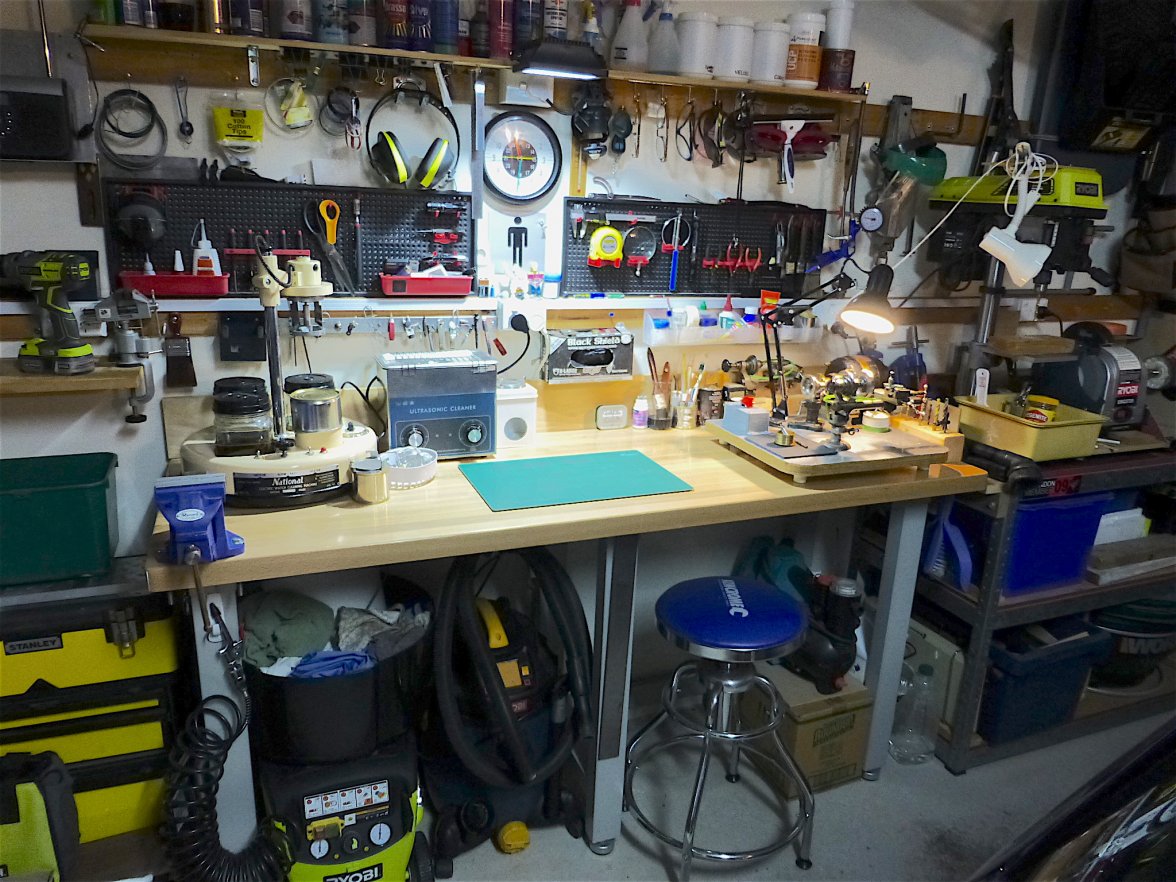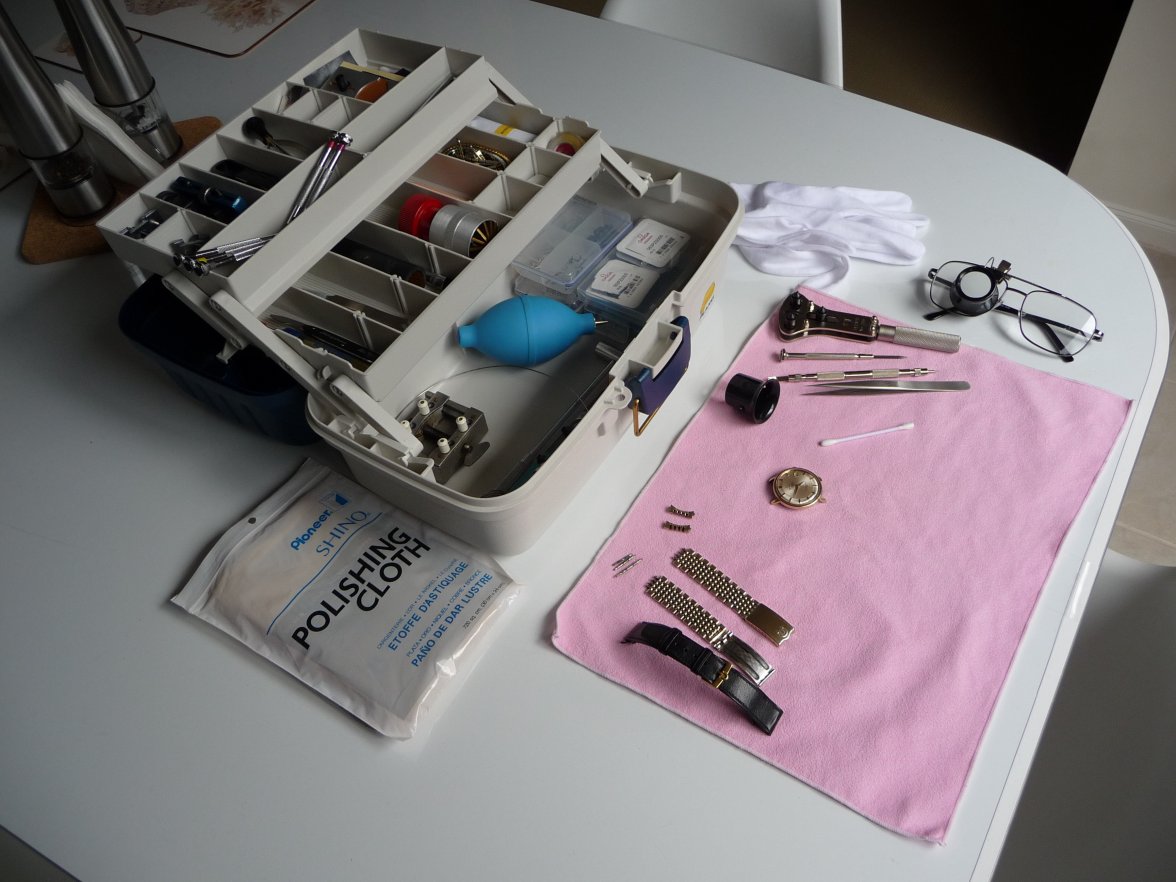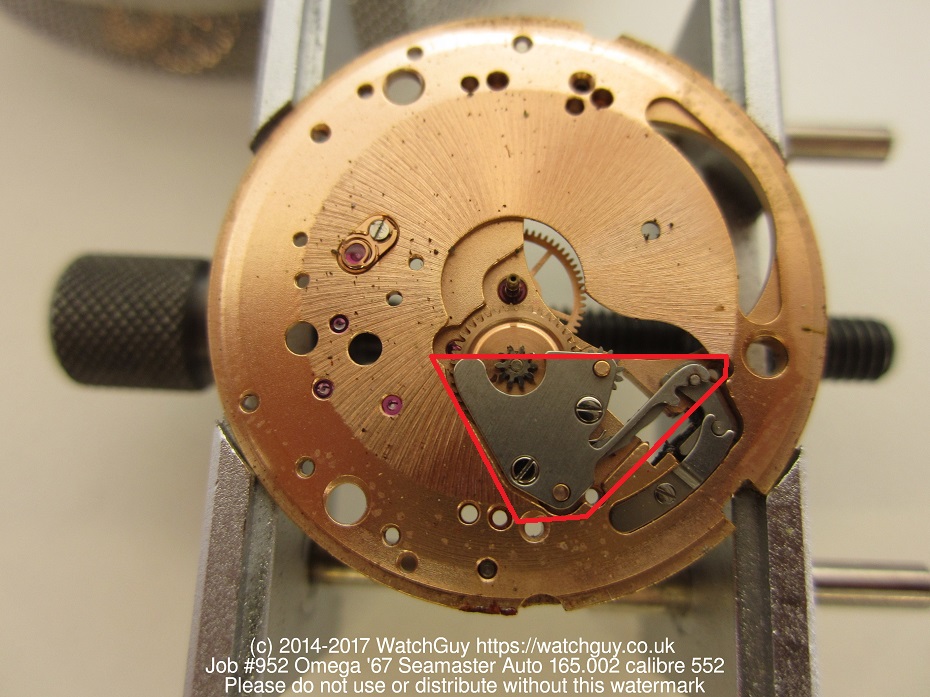I have the technology!
ConElPueblo
·Best meme. Ever.
François Pépin
·Gotta love this guy!
Reminds me of Walter White's lab in "Breaking Bad" !
Pretty sure it not only for watches - see the upper level...
ConElPueblo
·So, delving deeper into the mysterious world of watchmaking (ahem), I had a bit of a bad surprise today. I had removed the dial of a cal. 551 Omega, and a broken part of the movement was stuck at the underside of the dial 🙁
I took the liberty of stealing the below photo from watchguy.co.uk to show the part - am I correct in saying that it's the check spring? Looking in my old "Practical Watch Repairing" seems to suggest that.
I took the liberty of stealing the below photo from watchguy.co.uk to show the part - am I correct in saying that it's the check spring? Looking in my old "Practical Watch Repairing" seems to suggest that.
Archer
··Omega Qualified WatchmakerWhat the name is depends a bit on where you trained in the world, what brands you work on, and how old you are. It could be called a number of things, such as a set spring, set bridge, setting lever spring...modern ETA movements it's called a setting lever jumper.
Omega calls this a setting lever spring, part 550-1110. Not an inexpensive part...
Cheers, Al
Omega calls this a setting lever spring, part 550-1110. Not an inexpensive part...
Cheers, Al
ConElPueblo
·Cool, thanks for the explanation 😀
I did a search and it would seem it's about £/$45...
I did a search and it would seem it's about £/$45...
Archer
··Omega Qualified WatchmakerWas expecting more gouging...I serviced a watch last year where someone didn't want to buy a new one, so they made one...proper Omega part on the left (not that I really would have to point that out):


It didn't fit quite right, so the post that holds the setting wheel was chewed up badly by the burrs left on this part. Making parts is a great skill to have, but when you do it, make sure it doesn't cause other damage in the process!

BTW it was also too soft so didn't have any spring to it really. If someone is contemplating making one, I have heard that old hacksaw blades work well...
ConElPueblo
·Haha!
That's fantastic 😁
That's fantastic 😁
ConElPueblo
·Well, with great curiosity comes, eh, interesting results.
I recently bought a Constellation in so-so condition (the broken setting lever spring was in this!) that I've intended to being a testing ground for some mucking about. The dial was pretty spotted and not too attractive, so I thought - what the hell, let's try to clean it.
Before:

Now:
The Constellation dial seems rather solidly "built", which was one of the reasons I dared do this. I wouldn't try it with an older variety!
One of the biggest improvements came from removing the unsigthly rust from the seconds hand, I used wet sanding paper (grit 2500) and took care to avoid applying to much pressure and bending it out of shape.
By dismantling it and fooling around (responsibly, IMO!) I have learned that the setting lever spring was broken and the glass a size too small in diameter (it nearly fell out by itself!), which may have something to do with why there was some signs of moisture ingress on the dial/hands. The movement doesn't seem too bad, even though it has obviously been fondled by someone who couldn't make his pay stretch to finger cots. Or a decent case opener 🤦
I recently bought a Constellation in so-so condition (the broken setting lever spring was in this!) that I've intended to being a testing ground for some mucking about. The dial was pretty spotted and not too attractive, so I thought - what the hell, let's try to clean it.
Before:
Now:
The Constellation dial seems rather solidly "built", which was one of the reasons I dared do this. I wouldn't try it with an older variety!
One of the biggest improvements came from removing the unsigthly rust from the seconds hand, I used wet sanding paper (grit 2500) and took care to avoid applying to much pressure and bending it out of shape.
By dismantling it and fooling around (responsibly, IMO!) I have learned that the setting lever spring was broken and the glass a size too small in diameter (it nearly fell out by itself!), which may have something to do with why there was some signs of moisture ingress on the dial/hands. The movement doesn't seem too bad, even though it has obviously been fondled by someone who couldn't make his pay stretch to finger cots. Or a decent case opener 🤦
STANDY
··schizophrenic pizza orderer and watch collectorDid you remove the hands to sand them.?
ConElPueblo
·Did you remove the hands to sand them.?
Yep. I only sanded the seconds hand, but as I had the dial removed to clean it in the first place, they were off to begin with. Used a pair of hands levers with a protective plastic sheet over the dial.
STANDY
··schizophrenic pizza orderer and watch collectorWell..... you have moved along young grasshopper. 😉
JimInOz
··Melbourne AustraliaHoly crap!
Watch out Al, competition is looming on the horizon 😉.
And to Troels, good work with your hand removal technique, that wouldn't be guidance from our mentor would it?
Keep it up mate, it's a thoroughly relaxing pastime (until you ping a screw off into the wilderness!).
Watch out Al, competition is looming on the horizon 😉.
And to Troels, good work with your hand removal technique, that wouldn't be guidance from our mentor would it?
Keep it up mate, it's a thoroughly relaxing pastime (until you ping a screw off into the wilderness!).
ConElPueblo
·Holy crap!
Watch out Al, competition is looming on the horizon 😉.
And to Troels, good work with your hand removal technique, that wouldn't be guidance from our mentor would it?
Keep it up mate, it's a thoroughly relaxing pastime (until you ping a screw off into the wilderness!).
Eh... I don't think anyone should be afraid of me moving in on the watchmaking territory. It really is fun, but I could easily see it being extremely expensive. I would love to be able to give my time-only watches a reasonable service, but that is as far as my dreams go. I do a bit of research before diving into the various subjecs and when I looked at different hand removal tools, I remembered a thread on here where Al recommended levers. They work perfectly, I must say, and I like the control of the proces they give and the nice level of feedback.
François Pépin
·Eh... I don't think anyone should be afraid of me moving in on the watchmaking territory. It really is fun, but I could easily see it being extremely expensive. I would love to be able to give my time-only watches a reasonable service, but that is as far as my dreams go. I do a bit of research before diving into the various subjecs and when I looked at different hand removal tools, I remembered a thread on here where Al recommended levers. They work perfectly, I must say, and I like the control of the proces they give and the nice level of feedback.
I like levers too! I would not go back to the other removing tools I used to use before.
I have seen watchmakers that also use them for hairspring removal from the balance. I have tried and I do not feel comfortable with that way. For the moment I prefer to use little and sharp screwdrivers - but maybe it is because I have levers too big for that operation.
Al, can I ask you what tool you use to remove hairsprings from the balance?
Similar threads
- Posts
- 3
- Views
- 683
- Posts
- 4
- Views
- 812
- Posts
- 9
- Views
- 755
- Posts
- 7
- Views
- 1K





![DSC_0424[1].JPG DSC_0424[1].JPG](https://omegaforums.net/data/attachments/334/334967-ef958fca608d88e2954c167a388e0430.jpg?hash=75WPymCNiO)